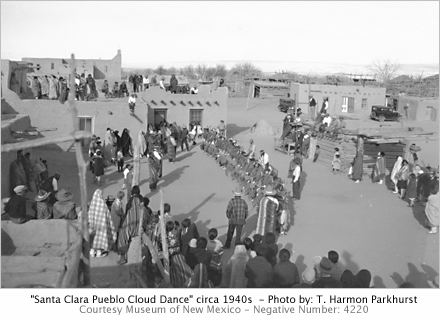Country United States FIPS code 35-70390 Elevation 1,709 m Population 980 (2000) Area code 505 | Time zone Mountain (MST) (UTC-7) GNIS feature ID 0928813 Area 5.439 km² Zip code 87532 Added to NRHP 5 November 1974 | |
 | ||
Santa Clara Pueblo (Tewa: Kha'po) is a census-designated place (CDP) in Rio Arriba County, New Mexico, United States. The population was 980 at the 2000 census, although, approximately 3,800 reside on the reservation. Santa Clara Pueblo was established about 1550.
Contents
- Map of Santa Clara Pueblo NM 87532 USA
- Geography
- History
- Arts
- Demographics
- Notable tribal members and residents
- References
Map of Santa Clara Pueblo, NM 87532, USA
The pueblo is a member of the Eight Northern Pueblos, and the people are from the Tewa ethnic group of Native Americans who speak the Tewa language. The pueblo is on the Rio Grande, between Ohkay Owingeh (formerly San Juan Pueblo) to the north and San Ildefonso Pueblo to the south. Santa Clara Pueblo is famous for producing hand-crafted pottery, specifically blackware and redware with deep engravings. The pueblo is listed on the National Register of Historic Places.
Geography
Santa Clara Pueblo is located at 35°58′16″N 106°5′21″W (35.971124, -106.089111), about 1.5 miles south of Española on NM 30.
According to the United States Census Bureau, the CDP has a total area of 2.1 square miles (5.4 km²), all of it land.
History
Pueblo peoples lived in the area for millennia before they met Juan de Oñate and his exploration party on July 11, 1598. Pueblo archaeology shows that Ancient Pueblo Peoples lived in the general region as far back as 1200BC.
First visited in 1541, a segment of Francisco Vásquez de Coronado's expeditionary force met with the residents of the nearby Caypa pueblo. After annexation of the region into the Spanish Kingdom, and as part of the 1601 expansion of Oñate's colonial capital, a chapel was built there by 1617. Fray Alonso de Benavides established a mission in 1628.
History shows that the mission was abandoned on the lead up to the revolt. The pueblo would join forces with others and would fight against the Spanish royal government in 1680 in the Great Pueblo Revolt. The original and unoccupied chapel was destroyed. Two other chapel buildings would be constructed there. The current church replaced the former in 1918. In 1782, a small pox outbreak decimated the population. The eighth section of the Act of July 22, 1854 mandated a census of the newly acquired possessions of the US government. In review of the land's title, the pueblo presented a Spanish Royal decree dated October 15, 1713 that the title to land and various pueblos could be expected. Though lost, the decree on the title papers, if ever they existed, assured protection of the pueblos' right to protection of their homelands from encroachment. The result of the title research led the pueblo community to be of the first recognized by Congress.
Arts
Pueblo potters are known for their black polished and red polychrome pottery.
Demographics
As of the census of 2000, there were 980 people, 349 households, and 254 families residing in the CDP. The population density was 471.6 people per square mile (181.9/km²). There were 400 housing units at an average density of 192.5 per square mile (74.3/km²). The racial makeup of the CDP was 6.53% White, 85.61% Native American, 0.10% Asian, 0.10% Pacific Islander, 6.12% from other races, and 1.53% from two or more races. Hispanic or Latino of any race were 17.45% of the population.
There were 349 households out of which 34.4% had children under the age of 18 living with them, 41.5% were married couples living together, 22.9% had a female householder with no husband present, and 27.2% were non-families. 22.6% of all households were made up of individuals and 7.7% had someone living alone who was 65 years of age or older. The average household size was 2.81 and the average family size was 3.29.
In the CDP, the population was spread out with 28.3% under the age of 18, 11.9% from 18 to 24, 29.4% from 25 to 44, 19.5% from 45 to 64, and 10.9% who were 65 years of age or older. The median age was 32 years. For every 100 females there were 95.2 males. For every 100 females age 18 and over, there were 85.5 males.
The median income for a household in the CDP was $20,302, and the median income for a family was $22,049. Males had a median income of $23,750 versus $20,221 for females. The per capita income for the CDP was $9,311. About 30.5% of families and 29.6% of the population were below the poverty line, including 27.3% of those under age 18 and 37.1% of those age 65 or over.
